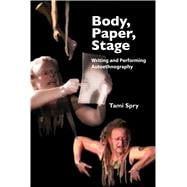
Note: Supplemental materials are not guaranteed with Rental or Used book purchases.
Purchase Benefits
What is included with this book?
| Foreword: Performing Authoethnography: Making the Personal Political | p. 11 |
| Preface: Autoethnography Lost and Found | p. 15 |
| Acknowledgments | p. 17 |
| Introduction: The Textualizing Body | p. 19 |
| Body | p. 41 |
| Conceptualizing Performative Autoethnography | |
| Why Do Performative Autoethnography? | p. 41 |
| Self-Other-Context | p. 51 |
| Connection | p. 52 |
| Performative Autoethnography and the Performative-I Disposition | p. 53 |
| Agency and Representation | p. 57 |
| Embodiment | p. 62 |
| Rupture and Fragmentation | p. 65 |
| In-and-Between Bodies | p. 66 |
| The Performance Studies Classroom and Beyond | p. 70 |
| Questions for Further Consideration | p. 75 |
| Paper | p. 77 |
| Writing the Body | |
| Putting the Body On Paper, or, Writing the Performative Body | p. 100 |
| Our Relationship with Language | p. 101 |
| Autoethnography Descriptives | p. 103 |
| An Ethic of Aesthetics in Performative Autoethnography | p. 105 |
| Language of the Body | p. 107 |
| Aesthetic Accountability | p. 109 |
| The Answerable Body | p. 110 |
| Questions for Further Consideration | p. 114 |
| Paper | p. 115 |
| Composing Performative Autoethnography | |
| Writing Bodies into Being | p. 115 |
| Methodology for Composing Performative Autoethnography | p. 126 |
| Sociocultural Context | p. 128 |
| Critical Self-Reflection | p. 129 |
| Self-Other Interaction | p. 132 |
| The Body | p. 133 |
| Ethics | p. 134 |
| Form | p. 140 |
| Research | p. 145 |
| Metaphor | p. 148 |
| Time and Space | p. 148 |
| Additional Persona | p. 150 |
| Structuring Performative Autoethnography: From Fragments to Collage | p. 151 |
| Warm-ups for Writing Performative Autoethnography | p. 153 |
| Stage | p. 157 |
| Performing the Autoethnographic Body | |
| Why Perform Autoethnography? | p. 157 |
| Conceptualizing Performance | p. 160 |
| The Weight of Performative Embodiment: Putting Flesh on the Bones of Discourse | p. 162 |
| Practiced Vulnerability as Agency | p. 167 |
| Who and What Are We Performing in Performative Autoethnography? | p. 171 |
| Questions for Further Consideration | p. 177 |
| Stage | p. 179 |
| Embodying Performative Autoethnography | |
| Elements of an Embodied Performance | p. 182 |
| Artistic Work Ethic | p. 183 |
| Dialogical Performance | p. 185 |
| Preparing for Rehearsal | p. 188 |
| Internal/External Dichotomy | p. 189 |
| Analyzing Internal Elements | p. 192 |
| Connecting Internal and External Elements for Performance Choices | p. 194 |
| Making Performance Choices of Voice, Body, Audience, and Space | p. 196 |
| Warm-ups for Embodying Performative Autoethnography | p. 206 |
| Body, Paper, Stage and Back Again | p. 209 |
| References | p. 213 |
| Index | p. 225 |
| About the Author | p. 231 |
| Table of Contents provided by Ingram. All Rights Reserved. |
The New copy of this book will include any supplemental materials advertised. Please check the title of the book to determine if it should include any access cards, study guides, lab manuals, CDs, etc.
The Used, Rental and eBook copies of this book are not guaranteed to include any supplemental materials. Typically, only the book itself is included. This is true even if the title states it includes any access cards, study guides, lab manuals, CDs, etc.